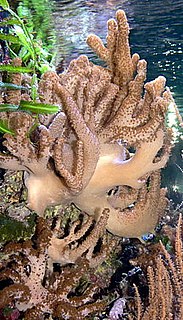
Alcyonacea, or soft corals, are an order of corals. In addition to the fleshy soft corals, the order Alcyonacea now contains all species previously known as "gorgonian corals", that produce a more or less hard skeleton, though quite different from "true" corals (Scleractinia). These can be found in suborders Holaxonia, Scleraxonia, and Stolonifera. They are sessile colonial cnidarians that are found throughout the oceans of the world, especially in the deep sea, polar waters, tropics and subtropics. Common names for subsets of this order are sea fans and sea whips; others are similar to the sea pens of related order Pennatulacea. Individual tiny polyps form colonies that are normally erect, flattened, branching, and reminiscent of a fan. Others may be whiplike, bushy, or even encrusting. A colony can be several feet high and across, but only a few inches thick. They may be brightly coloured, often purple, red, or yellow. Photosynthetic gorgonians can be successfully kept in captive aquaria.

The Corallinaceae are one of the two extant Coralline families of red algae; they are differentiated from the morphologically similar Sporolithaceae by their formation of grouped sporangial chambers, clustered into sori. The Corallinoideae is monophyletic; the other subfamilies form another monophyletic group.
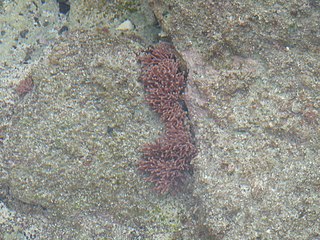
Amphiroa is a genus of thalloid red algae comprising 55 species. Specimens can reach around 30 cm in size. The thalli take a crustose form; dichotomous branches are formed. The organisms possess secondary pit connections. Amphiroa reproduces by means of conceptacles; it produces tetraspores. Its pore canals are lined with parallel filaments; the morphology of the pore canal is a key trait used to delineate species within the genus.
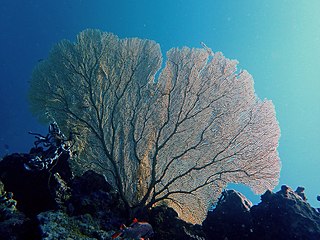
Scleraxonia is a suborder of corals, a member of the phylum Cnidaria.

Gorgoniidae is a family of soft corals, a member of the subclass Octocorallia in the phylum Cnidaria. Nearly all the genera and species are native to the east and west coasts of America.

Jania is a genus of red seaweeds with hard, calcareous, branching skeletons in the family Corallinaceae. Members of the genus are found in sheltered reef habitats, often in crevices or other shaded areas.

Plexaura is a genus of gorgonian-type octocorals in the family Plexauridae.

Sertulariidae is a family of hydrozoans.

Aglaopheniidae is a family of hydrozoans.

Aglaophenia is a genus of hydrozoans in the family Aglaopheniidae.
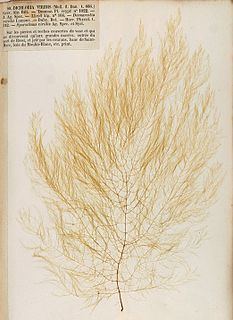
Desmarestia is a genus of brown algae found worldwide. It is also called acid weed, acidweed, oseille de mer, sea sorrel, ウルシグサ, stacheltang, mermaid's hair, landlady's wig, or gruagach. However, 'sea sorrel' can also specifically refer to Desmarestia viridis. Members of this genus can be either annual or perennial. Annual members of this genus store sulfuric acid in intracellular vacuoles. When exposed to air they release the acid, thereby destroying themselves and nearby seaweeds in the process. They are found in shallow intertidal zones.
Crisia is a genus of bryozoans in the family Crisiidae. Some species are known from the fossil record.

Dictyota is a genus of seaweed in the family Dictyotaceae. Species are predominantly found in tropical and subtropical seas, and are known to contain numerous chemicals (diterpenes) which have potential medicinal value. As at the end of 2017, some 237 different diterpenes had been identified from across the genus.
Candidae is a family of gymnolaematan bryozoans.

Clytia is a genus of hydrozoans belonging to the family Campanulariidae.
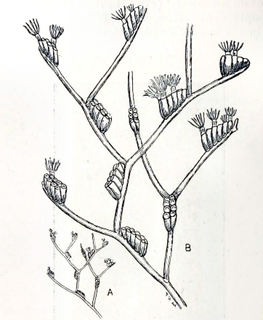
Amathia is a genus of bryozoans belonging to the family Vesiculariidae.

Delesseria is a genus of red algae belonging to the family Delesseriaceae.
Eucrateidae is a family of bryozoans belonging to the order Cheilostomatida. The family consists of only one genus: EucrateaLamouroux, 1812.

Vesiculariidae is a family of bryozoans belonging to the order Ctenostomatida.














